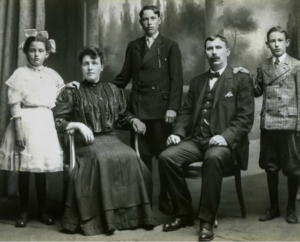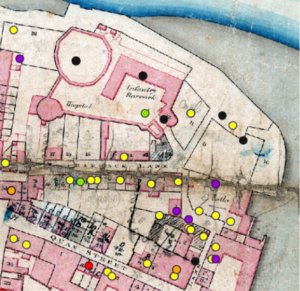All summer, I have been waiting for the release of the Digital Atlas of Dungarvan, a project spearheaded by the Royal Irish Academy. For more than 30 years, the Royal Irish Academy has published the Irish Historic Towns Atlas series, which visually records the growth of Irish cities and towns. The digital atlas of Dungarvan was released on August 18, joining prior digital publications for Derry and Galway. A published version will be released this fall.
My mother’s great-grandmother, Catherine Hayes, was born in 1875 on Barrack Lane in Dungarvan, County Waterford, to John Hayes and Mary Flynn. She emigrated to Boston in her teens with her parents and several siblings, and in 1893, she married Patrick Joseph Garvin of Mallow, County Cork. One of my favorite family photos is of Catherine, her husband, and their three children. Probably taken between 1905 and 1910, the photo depicts a proud and impeccably dressed family. I know little of Catherine Hayes and was excited to explore Dungarvan via this new atlas.
The Digital Atlas allows the user to choose different map layers and to plot sites of interest. For example, you can overlay the 1851 historic town plan of Dungarvan and then choose “Streets” to depict the location of historic streets.
In the 1870s, the Hayes family lived on Victoria Lane, now Home Rule Street, in an area known as Abbeyside. Located on the east bank of the Colligan River, Abbeyside earned its name from the Augustinian friary established in 1290. From this atlas, I learned that Victoria Lane was a short walk to McGrath’s Castle, which stood from 1630s until the early twentieth century.
By 1875, the Hayes family had moved to the west bank of the Colligan River and what is now Dungarvan city center. At that time, they lived on Barrack Lane, now Castle Street. Located adjacent to Dungarvan Castle and the former infantry barracks, Barrack Lane was narrow and featured crowded buildings. The Digital Atlas allowed me to plot manufacturing sites, where I learned that a manure yard and a lime kiln operated nearby when Catherine and her family resided in the neighborhood. Though located in busy and bustling Dungarvan, Barrack Lane seemed like a difficult place to raise a family. I can only guess that the Hayes family emigrated to Boston for economic reasons, as they searched for new opportunities in America. I’m grateful for this new atlas, as it provides insight into the life of an ancestor about whom I knew little. This October, the print version of the Irish Historic Town Atlas of Dungarvan will be released; I’m hopeful that this publication will reveal even more about the life of Catherine Hayes and help me to understand more about her early life in Dungarvan.
Share this:
About Sheilagh Doerfler
Sheilagh, a native of Chelmsford, Massachusetts, received her B.A. in History and Communication from the University of Massachusetts-Amherst. Her research interests include New England, Norway, Sweden, Ireland, Westward Migration, and adoptions.View all posts by Sheilagh Doerfler →

